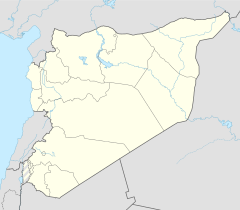มัสยิดใหญ่แห่งอะเลปโป
หน้าตา
| มัสยิดใหญ่แห่งอะเลปโป | |
|---|---|
جَـامِـع حَـلَـب الْـكَـبِـيْـر | |
 ภาพพาโนรามาใน ค.ศ. 2010 | |
| ศาสนา | |
| ศาสนา | อิสลาม |
| สถานะ | ปิดชั่วคราว |
| ที่ตั้ง | |
| ที่ตั้ง | อำเภอ Al-Jalloum อะเลปโป ประเทศซีเรีย |
| พิกัดภูมิศาสตร์ | 36°11′58″N 37°09′25″E / 36.199492°N 37.156911°E |
| สถาปัตยกรรม | |
| สถาปนิก | Hasan ibn Mufarraj al-Sarmini |
| ประเภท | มัสยิด |
| รูปแบบ | ก่อนอิสลาม,[a] ซีเรียเหนือ, อุมัยยะฮ์, เซลจุค, มัมลูก |
| เสร็จสมบูรณ์ | ค.ศ. 715, คริสต์ศตวรรษที่ 13 |
| ลักษณะจำเพาะ | |
| โดม | 1 |
| หอคอย | 1 (ถูกทำลายในสงครามกลางเมืองซีเรีย) |
| วัสดุ | หิน |
มัสยิดใหญ่แห่งอะเลปโป (อาหรับ: جَـامِـع حَـلَـب الْـكَـبِـيْـر) เป็นมัสยิดที่ใหญ่ที่สุดและหนึ่งในมัสยิดที่เก่าแก่ที่สุดในนครอะเลปโป ประเทศซีเรีย ตั้งอยู่ในอำเภอ al-Jalloum ของเมืองโบราณอะเลปโป แหล่งมรดกโลกใกล้กับทางเข้าซูกุลมะดีนะฮ์ มีการอ้างว่ามัสยิดนี้เป็นที่เก็บศพของเศคาริยาห์ บิดาของยอห์นผู้ให้บัพติศมา ซึ่งทั้งสองคนได้รับการนับถือทั้งในศาสนาอิสลาม[5][6] และศาสนาคริสต์[7] มัสยิดนี้สร้างขึ้นในช่วงต้นคริสต์ศตวรรษที่ 8 แต่อาคารปัจจุบันสืบไปได้ถึงคริสต์ศตวรรษที่ 11 ถึง 14 หออะษานในมัสยิดสร้างขึ้นใน ค.ศ. 1090[8] และถูกทำลายในระหว่างสงครามกลางเมืองซีเรียในเดือนเมษายน ค.ศ. 2013[9]
หมายเหตุ
[แก้]- ↑ Hillenbrand (1994),[1] Raby (2004),[2] และ Museum with No Frontiers;[3] ระบุคริสต์ศตวรรษที่ 7 เป็นจุดเริ่มต้นของสถาปัตยกรรมอิสลาม[4]
อ้างอิง
[แก้]- ↑ Robert, Hillenbrand (1994), Necipoglu, Gulru (บ.ก.), Islamic Architecture: Form, Function, and Meaning, Columbia University Press, p. 140,
At the top is the main cornice of the tower. It is made of flat niches – as opposed to concave muqarnas cells – and entirely decorated with tiny arabesques. The style of this minaret's decoration reveals the continuity of Syrian pre-Islamic and Roman architectural heritage.
- ↑ Raby, Julian (2004), Necipoglu, Gulru (บ.ก.), "Nur Al-Din, the Qastal al-Shuʿaybiyya, and the "Classical Revival"", Muqarnas 21 Essays in Honor of J.M. Rogers: An Annual on the Visual Culture of the Islamic World, Brill, 21, ISBN 9004139648,
… they perpetuate the outer shell of pre-Islamic Syrian towers, of which the minarets of the mosques of Aleppo and Ma'arrat al-Nu'man preserve ...
- ↑ "Discover Islamic Art". Museum with No Frontiers. 2004–2018. สืบค้นเมื่อ 2018-03-14.
- ↑ Palmer, A. L. (2016-05-26). Historical Dictionary of Architecture (2 ed.). Rowman & Littlefield. pp. 185–236. ISBN 978-1442263093.
- ↑ "The Great Mosque of Aleppo | Muslim Heritage". www.muslimheritage.com. 24 March 2005. สืบค้นเมื่อ 2016-06-30.
- ↑ The Great Mosque (The Umayyad Mosque) เก็บถาวร 2008-11-03 ที่ เวย์แบ็กแมชชีน Syria Gate.
- ↑ พระวรสารนักบุญลูกา, 1:5-79 KJV:Luke 1:5–79
- ↑ ed. Mitchell, 1978, p. 231.
- ↑ "Syria clashes destroy ancient Aleppo minaret". bbc.co.uk. 24 April 2013. สืบค้นเมื่อ 24 April 2013.
บรรณานุกรม
[แก้]- Bacharach, Jere L. (1996). "Marwanid Umayyad Building Activities: Speculations on Patronage". ใน Gulru Necipoglu (บ.ก.). The Encyclopaedia of Islam Part 157. Vol. 13. BRILL. ISBN 9004106332.
- Brend, Barbara (1991). Islamic Art. Harvard University Press. ISBN 067446866X.
great mosque aleppo minaret.
- Grousset, Rene (1991). The Empire of the Steppes: A History of Central Asia. Rutgers University Press.
- Martijin Theodoor Houtsma, บ.ก. (1987). E.J. Brill's First Encyclopaedia of Islam 1913–1936. Vol. 3. BRILL. ISBN 9004082654.
- George Mitchell, บ.ก. (1978). Architecture of the Islamic World. Thames and Hudson.
- Tabaa, Yasser (1997). Constructions of power and piety in medieval Aleppo. Penn State Press. ISBN 0-271-01562-4.
- Vandekerckhove, Dweezil (2019). Medieval Fortifications in Cilicia: The Armenian Contribution to Military Architecture in the Middle Ages. BRILL. ISBN 9789004417410.
แหล่งข้อมูลอื่น
[แก้]วิกิมีเดียคอมมอนส์มีสื่อที่เกี่ยวข้องกับ มัสยิดใหญ่แห่งอะเลปโป

